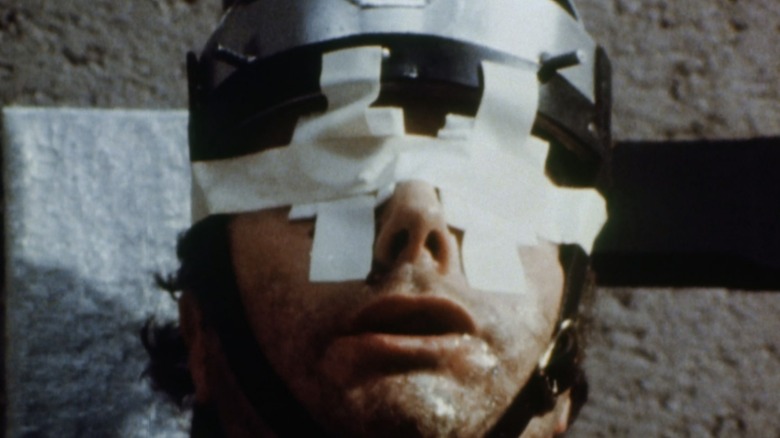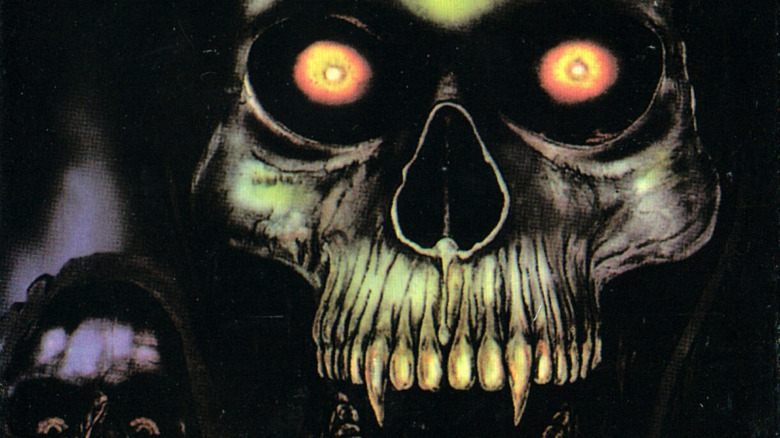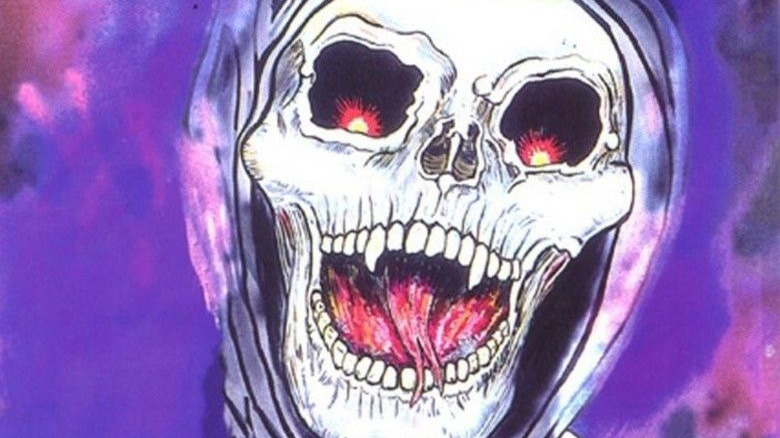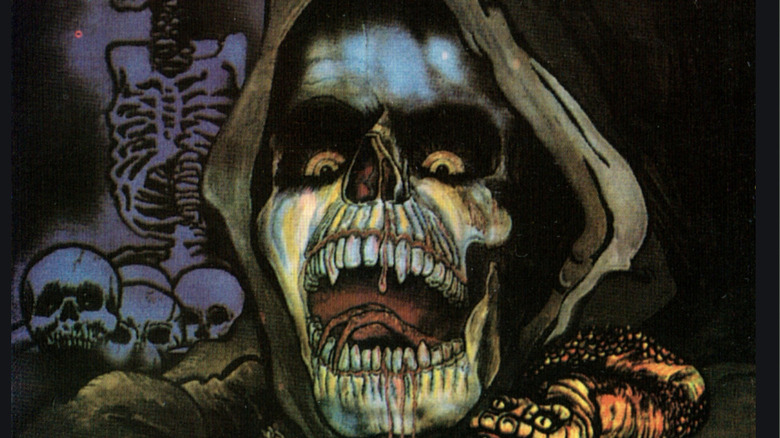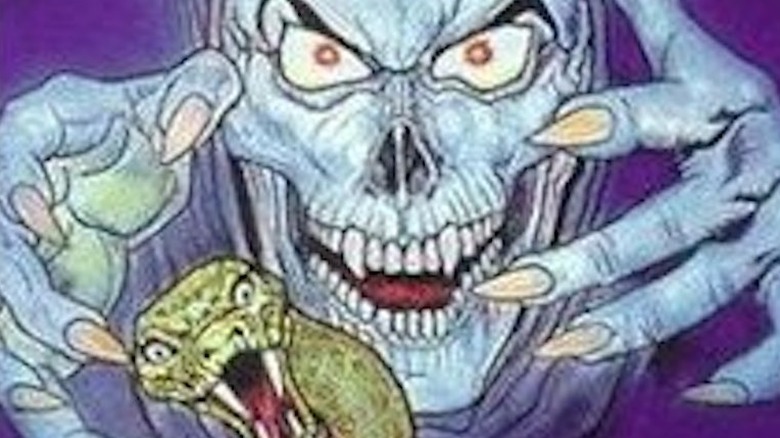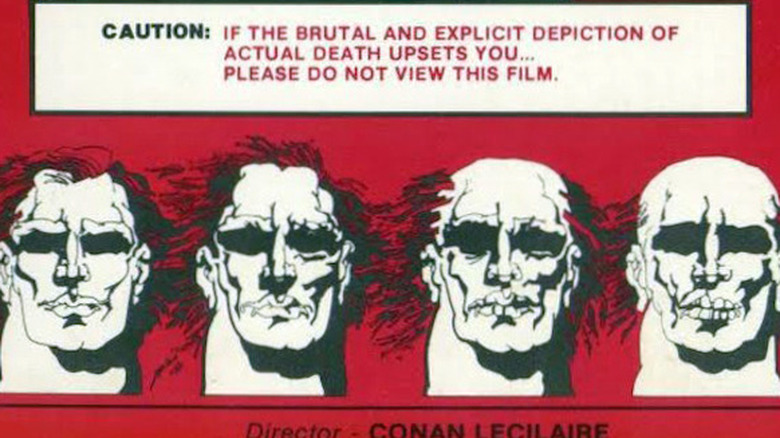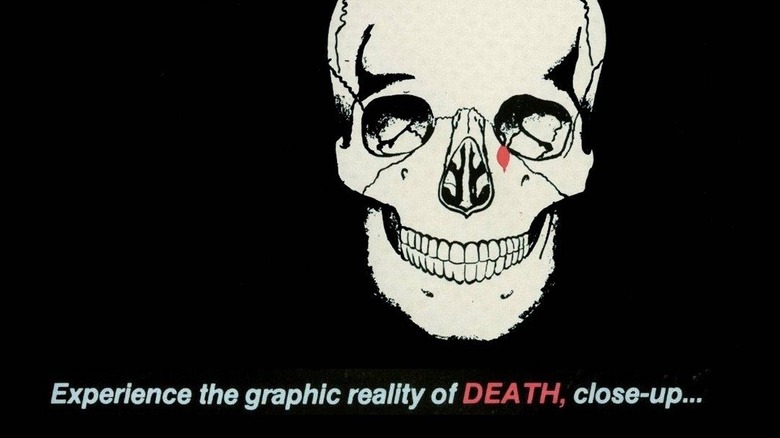Every Faces Of Death Movie Ranked Worst To Best
Well, well, well shame on you for clicking this article. But at least you know what you're getting into, right? Right?
As a franchise, "Faces of Death'" is best approached (if at all) with a hazmat suit, a good defense lawyer, and as much historical context as possible to soften the crushing, shameful blow that invariably follows from this level of extreme rubbernecking. Framed in the ostensibly authority-granting glow of the documentary format, each entry in the "Faces of Death" series purports to scratch the same, unabashedly grim itch: presenting the viewer with a string of footage depicting the many gruesome paths to the wrong side of the grave. These clips come from a variety of sources, some of them faked, others ... not so fake. It is a truth universally acknowledged that animals do not fare well in the tasteless wastes of 1970s exploitation cinema. But when your target audience is the kind of person liable to prod bloated roadkill with a limp stick, all justified cries of "you should be ashamed of yourself" fall on deaf ears (presumably those of series writer/director John Alan Schwartz).
If that three-pound lump of jelly between your ears is functioning normally, you're probably asking yourself an important question. Namely: "Why? Why do these movies even exist?" The short answer is money (the first film supposedly made millions on a budget of $15,000). The long answer, of course, is far more complicated. Was "Faces of Death" doing anything unique in its morbid, flagrantly controversy-courting provocations? Haven't humans, in our endless depravity, always found ways to turn suffering into entertainment, from public hangings to novelty teenage tragedy songs? Ultimately, the existence of the "Faces of Death" franchise is unfortunate, but unsurprising. There will always be ironic masochists, drawn to the lamplight of shock cinema (or, in today's digital landscape, unlisted YouTube videos). This is a destructive franchise for self-destructive people; a mostly-fictionalized meta-snuff flick that promises (and sometimes delivers) real deaths captured on film for the video-consuming world to gawk at.
As a franchise, "Faces of Death" is the literal definition of beating a dead horse. Each entry in the series does precisely what it says on the clamshell, though never quite living up to the garish impact of its original 1978 installment — a film that has more than earned its reputation as one of the most shocking films ever made. To that end, the series' place in horror history, in the tradition of the mondo shockumentary, cannot be denied. For that, it's worth assessing the franchise as a whole — with rankings provided by the voting denizens of the Internet Movie Database. So plug your nose, and let's dive in.
8. Faces of Death VI (1996)
If you wade deep enough through the scummier side of exploitation home video offerings, you will eventually face-plant smack dab into the bottom of the barrel: the sixth installment of "Faces of Death." Only, "sixth installment" isn't actually the most accurate description of what "Faces of Death VI" has to offer.
Understanding the dishonesty of this nomenclature will help to solidify the film's deserving position at the back of this list. See, while its name might suggest a brand new assortment of tasteless morbid vignettes, "Faces of Death VI" is, in fact, a "highlight" reel (if you can call it that) of previous entries in the series. Released in 1996, this compilation features clips from scenes shown in the original "Faces of Death," "Faces of Death IV," and, most ridiculously, re-recycled footage from "Faces of Death V," which is also a highlight reel. Previously-seen clips include the monkey-eating restaurant scene, the heart-ripping ritual, and the cannibalistic cult showcase (featuring a cameo from Schwartz, the longtime "Faces of Death" series mastermind).
As one LetterBoxd user aptly sums up, "If you've seen the first five then you've seen this one. Everything is just a rehash." "Faces of Death VI" doesn't just copy the more popular entries' homework, it's a completely superfluous cash grab that should only be considered if (and only if) you are unable to get your sinful, grubby little mitts on the original 1978 film. If a film is entirely made up of reused footage, surely even the strictest of completionists ought to be spared the torture.
7. Faces of Death V (1995)
The world is filled with many mysteries. One of them is why "Faces of Death V" is rated on IMDb ever-so-slightly higher than "Faces of Death VI," when they both commit precisely the same sin. Released one year before its equally copy-cat follow up, the fifth entry in the "Faces" franchise is another money-grubbing "best of the best" clip show of previous segments in the series, stripped predominantly from "Faces of Death" and "Faces of Death IV." Are you starting to see a pattern here?
We are once again "treated" to the infamous monkey scene which, and this cannot be stressed enough, becomes less shocking the more times you watch it — surely not the desired effect. Bringing nothing new to the table (just more of the same monkey brains), "Faces of Death V" should only be considered only as a last resort if earlier entries are unavailable, inaccessible, or if one has suffered from selective "Faces of Death" memory loss — in which case, we are jealous.
6. Faces of Death: Fact or Fiction? (1999)
This 1999 direct-to-video entry is framed around the scandal-courting question at the heart of the "Faces of Death" franchise. Namely: How much of this is real?
In "Faces of Death: Fact or Fiction?" John Alan Schwartz (a.k.a. Conan LeCilaire, a.k.a. Alan Black) weakly attempts to address the icky elephant in the room, unpacking the various controversies and mysteries surrounding the film series. Unfortunately for genuinely inquiring minds, "Fact or Fiction?" is every bit as slimy and self-promoting as the rest of the series, its only purpose to serve as a flagrant excuse to make another feature-length film out of old footage.
As one IMDb reviewer accurately summarizes: The film only "[divulges] about three scenes, and [packs] the rest with filler, such as stock footage from the other films." So, consider this your warning: If you are interested in the history of the series and where the line falls between manufactured gore and gruesome reality, there are far, far better sources than "Fact or Fiction?," which is more of a meta-promotional tool than a satisfying documentary.
While die-hard fans of the series may be tickled by the return of the bug-eyed Dr. Louis Flellis and the general smarminess of the whole affair, for a real behind-the-scenes peek into the series, check out the far-more-informative 30th anniversary Blu-ray extras.
5. Faces of Death III (1985)
If you've made it to the third installment in the series, you know full well what you're getting into. Namely: A whole lot of death and injury, some of it real.
"Faces of Death III" focuses primarily on serial killers, featuring protracted re-enactments of everything from crime scenes to courtroom sequences. What "Faces of Death III" has going for it, more than any installment in the series past or since, is unintentional comedy. Despite its best attempts to take itself ever so seriously, "Faces of Death III" jumps the shark (briefly) into a live-action "Looney Tunes" gag when a parachutist accidentally plummets into a Floridian crocodile enclosure. If it weren't for this marvelously-ridiculous segment, this installment in the series would likely not be this high up the list.
All told: "Faces of Death III" delivers what it promises: Exaggerated reenactments of murders, drug busts, and animal attacks (as well as some real footage of animal slaughter). It is trash, of course — but if you've crawled this far into the trenches of the "Faces of Death" series, you get what you pay for.
4. Faces of Death IV (1990)
Unleashed upon the direct-to-video world in 1990, "Faces of Death IV" follows in the form of its predecessors with a series of staged and ... not so staged death scenes. Currently holding court as the final for-real sequel in the series (in that it includes "original" footage), "Faces of Death IV" boasts a slew of new, grisly macabre incidents.
These include an unfortunate bungee jumping excursion, a magic trick gone sideways, a cocaine-fueled wedding, and a good old-fashioned Satanic ritual. The fourth installment of the series deviates from its more serious predecessors, careening (smartly) into the realm of camp. How else can you describe the barbecue eating, lava lamp-loving shenanigans of the film's narrator, Dr. Louis Flellis? Dr. Flellis (played by the director's brother, James B. Schwartz), is arguably the most interesting part of the film. His pun-loving "horror host" vibe lends an originality to the fourth "Faces of Death" that is lacking in the two preceding sequels.
As one Amazon user notes in their four-star review: "[the film] is not for everyone and probably shouldn't be for anyone but it is what it is and I like it." Featuring 50 separate scenes of "blood-chilling horror," as Gorgon Video's website boasts, the film earns bonus points for its end credits theme song, which is groovier than it has any right to be. But, in the end, "Faces of Death IV" suffers from the cardinal (if kind of impressive) franchise curse: finding a way to make a gruesome, provocative clip show feel boring.
3. The Worst of Faces of Death (1987)
The first "play the hits" compilation in the "Faces of Death" series (but certainly not the last), "The Worst of Faces of Death" amalgamates disturbing clips from the first three films, including slaughterhouse footage and a pharmacy shootout. The clips are punctuated with brief introductory scenes of new "Faces of Death" series narrator Dr. Louis Flellis (James B. Schwartz), whose sardonic quips and hard left into tongue-in-cheek humor kicked off a lighter tonal shift in the series, which depending on the flavor of your bad taste, marks a positive re-brand for the franchise into more knowingly goofy territory.
Not to be confused with the 1992 German-language release "The Best of Faces of Death," (a forgivable mistake, given it is also a highlight reel), the 1987 compilation is, as far as "Faces" compilations go, the best. Say what you will (and given the footage of real-life autopsies, there's plenty to say), but the one thing you can't accuse "The Worst of Faces of Death" of is dishonesty. As one Letterboxd user aptly summarizes, for better or for worse, this is the kind of film where the title reviews itself.
2. Faces of Death II (1981)
The first sequel to the mondo original that started it all, "Faces of Death II" picks up the sickening baton of its predecessor, largely focusing on stunts gone wrong and sports-related fatalities. Narrated once again by the fictional Dr. Francis B. Gröss (Michael Carr), the film features an 85-minute back-to-back clip show of staged and real footage of on-screen deaths, from daredevil Kenny Powers' ill-fated attempt to launch a rocket-powered car a mile over the Saint Lawrence River (most likely pulled from the amazing documentary "The Devil at Your Heels") to the infamous 1980 boxing match between Johnny Owen and Lupe Pintor, wherein the former sustained injuries that later ended his life.
Some "Faces of Death" completionists go so far as to argue that the second entry in the series is even "better" than the original, though such claims should be taken with an enormous, caveat-coated grain of salt depending entirely on one's individual definition of "better."
"Faces of Death II" features far more upsetting footage than the original film (including public executions and a lot of dead animals) as well as more cynically-steeped, faux-academic tangents from Dr. Gröss (including a so-shocking-it's-almost-funny necrophilic opener). Like all the films in the series, "Faces of Death II" is absolutely (read: unequivocally) not for everyone, but if you're a sick puppy or a ruthless franchise finisher, it's fairly obvious that the direct sequel to the original entry deserves its nearly-top spot on this list. With a more serious bent and far fewer staged segments than the original, "Faces of Death II" is unwatchable and irredeemable — but that's kind of the whole point.
1. Faces of Death (1978)
The grotesque, rubber-necking original that started it all, "Faces of Death" was made with one goal and one goal only: to shock. And shock it did, does, and will. Mostly a collection of vignettes claiming to be stock footage depicting death and other violent sequences, the film was supposedly banned in over 40 countries, including the United Kingdom, a fact proudly displayed on the cover of the film's physical media releases.
Despite its very real sense of stomach-churning morbidity (this is a film with a lot of real animal slaughter after all), the original "Faces of Death" does hold some niche appeal to the strong-stomached scholars of exploitation cinema. Of all the non-retrospective entries in the series, the original "Faces of Death" features the most obviously fake segments, which, and we really cannot believe this needs to be said, is a good thing. We'll take a goofily fake killer alligator over the sinking shame that comes with the snuff territory any day. As an object of curiosity, morbid or otherwise, "Faces of Death" is worth a peek if you're the right kind of film freak. Though a thorough understanding not only of what you are getting into, but the film's place in the broader context of mondo horror, is highly encouraged.
Is it a sleazy relic? Yes. Has the once-scandalizing controversy lost its bite to more media-savvy audiences? Yes. But that's what makes it more of an interesting curio, which at the end of the day, is the most positive contribution "Faces of Death" has to offer to modern viewers. This is the film that is easiest to hold at arm's length, precisely because (and not in spite) of its fakery and existence in an ever-so-specific era of the video nasty. At its best, the film is crudely exploitative in the same way the torture chamber section of a wax museum is. The kernel of what the series would become (i.e. less re-enactments and more real footage) is there. But it's more in the background than its successors — and for that, the original remains the best of the worst.
